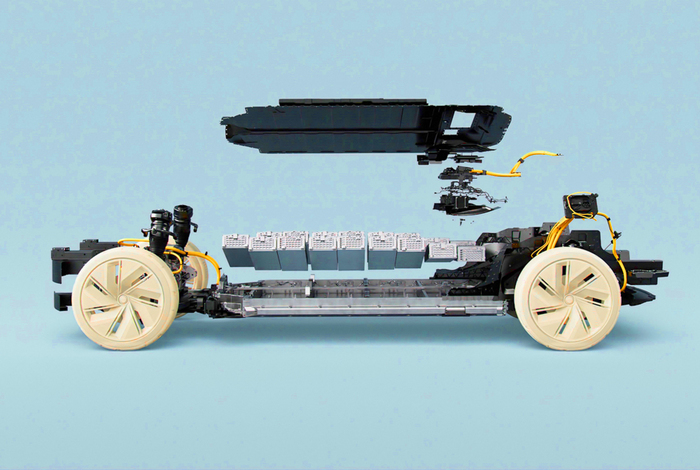Icon: enlarge
Big but peaceful: the Volvo VCC looks a bit like a boulder, covered by a thin layer of moss
Photo: Volvo
The word "hygge" was practically unknown outside Scandinavia in 2003.
Outside of Sweden, it would have been a good fit for the study that Volvo unveiled at the Geneva Motor Show.
Because the VCC model - an abbreviation for "Versatility Concept Car" (for example: Versatility Concept Car) - was homely, simple and natural in its own way.
The attributes are in the catchphrase "hygge" (according to Duden: homely) and stand for this form of Scandinavian lifestyle.
However, the car was not only ahead of its time in terms of its attitude to life, but also because of some technical refinements.
A solar module was integrated in the glass roof of the study, which extended over an X-shaped metal strut.
It generated electricity for a new type of air cleaner, the "Volvo Ambient Air Cleaner".
The filtered hydrocarbons and nitrogen oxides from the ambient air before they were fanned into the interior.
Thanks to the power supply from the roof module, the ventilation system also worked when the car was parked and the engine was switched off.
Bright ambience, filtered air
A desirable side effect of the glass roof: it was much brighter in the VCC than in conventional vehicles, which is why the already spacious car looked even more inviting and spacious.
In addition, with the panorama roof, the Volvo developers took up an idea that was still very fresh at the time.
On the study, the glass expanded over the entire roof section.
Clean air to breathe in a friendly, fresh interior - the car's drive system should also be as environmentally friendly as possible.
The Volvo engineers had developed an idiosyncratic hybrid system for this purpose.
It consisted of a six-cylinder in-line petrol engine with a displacement of 2.6 liters, turbocharging and 250 hp.
The engine was equipped with an automatic start-stop system and special engine technology: in partial load operation, it increased the compression in the cylinders so much that the particularly lean fuel-air mixture ignited itself.
In addition to these extras, there was a 42-volt electrical system including an electric motor that supported the petrol engine when accelerating and recovered electrical energy when the car rolled out.
The result of the effort was an average consumption of 6.5 liters per 100 kilometers.
According to the standard, an Audi A6 Avant with comparable performance from that time consumed 11.0 liters per 100 kilometers.
Volvo showed the way: Since 2016, there have been vehicle electrical systems with a slightly higher voltage (48 volts) in production cars of many brands, including Audi.
They also help regain energy.
Turning out of the mainstream
"Volvo dares to be different," said the then CEO Hans-Olov Olsson at the premiere of the VCC.
Instead of relying on more and more performance and speed, like the majority of manufacturers, Volvo was on the way to driving comfort and utility.
The VCC study should make this clear.
And at the same time it should remind of Volvo's tradition as a Nordic nonconformity and, above all, station wagon brand.
Because in 1953 Volvo had brought a station wagon onto the market for the first time with the model PV 445 "Duett", and the first half century of station wagon history was to be celebrated with the VCC.
After all, station wagons were still the best-selling types of the Swedish brand at the time, and it was above all the unpretentious long-tail cars that established Volvo's image as a manufacturer of almost indestructible everyday cars.
The surprises lie dormant in the stern
For the anniversary, the VCC was supposed to demonstrate that Volvo continued to rely on station wagons - even though the brand had presented an SUV for the first time the year before with the XC 90.
And so José Diaz de la Vega, who was in charge of strategic design at Volvo at the time, and his teams in Gothenburg and Barcelona came up with a few special features for the study hold.
There was an electrically retractable loading floor, a built-in safe in the right side wall and two large, separate storage compartments in the underbody, one of which could be cooled and the other heated.
Thermal compartments and safes did not make it into series production.
Other VCC ideas were found in later Volvo models - such as the reduced and cozy interior, the efficient drive technology and the distinctive yet sleek body.
The VCC study is now part of the Volvo Museum in Arendal, a suburb to the west of Gothenburg.
Icon: The mirror




